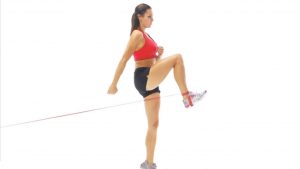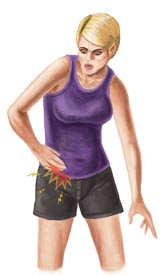Your hip flexors are a group of muscles that help with hip and knee flexion when you’re walking or running. The main muscles that make up your hip flexor are the rectus femoris, sartorius, tensor fasciae latae, and the iliopsoas muscle.
The iliopsoas is the most important hip flexor of them all since it’s responsible for swinging your knee upward to your torso when you try to walk or run.
Along with helping you with each step you take when you walk or run, your hip flexor muscles help you with various other activities that require hip flexion. As you can imagine, when your hip flexors become injured they can make it difficult to do simple tasks like bending over to pick something off the ground, or playing certain sports.
Hip Flexor Injury Causes
Injuries in the hip flexor can be caused by a variety of different things. However, tightness or shortness in the hip flexor is usually what causes injury.
According to Hip Flexors Info, hip flexor tightness often occurs when a person stays in a seated position for most of the day and then attempts to make a sudden movement.
When you’re habitually in a seated position your hip flexors will gradually shorten and tighten up on you. Shortness or tightness in your hip flexors makes it much easier to experience injuries in this area.
Hip Flexor Injury Symptoms
There are certain symptoms to look out for that will let you know if you have an injury in your hip flexors. Pain is the most common symptom you’ll experience when an injury to your hip flexor occurs.
You’ll experience a sharp pain in and around the front of your hips, and other areas like your lower back, hamstrings, and groin area. Other hip flexor injury symptoms to look out for include:
- Muscle spasms in and around your hip area.
- Swelling and inflammation around your hips.
- Signs of bruising around your hip area.
- Tightness in and around the hip area.
- Sharp pain in the lower back area.
- Signs of limping when you try to walk or run.
- When you touch your hip or groin area it feels very tender.
- Discomfort and aches in the front side of your hips.
- You begin noticing a clicking like sound in and around your hips.
Of course, there are various other symptoms besides the ones listed above associated with a hip flexor injury. For more information on symptoms associated with hip flexors click here.
How to Treat a Hip Flexor Injury

The best way to treat a hip flexor injury is to reduce the tightness in these muscles. There are various stretches and exercises you can begin doing daily to get relief from hip flexor tightness and speed up the healing process of your injured hip flexor muscles.
Below are a few of the best stretches and exercises for injured hip flexors. These exercises will help increase the mobility in your hip flexors so you can return to moving around without being in pain.
The Knee to Chest Stretch
The knee to chest stretch is a simple exercise that gradually loosens up the tightness in your hips and helps you recover faster.
To do the knee to chest stretch properly just follow the steps below:
- First you’ll need to lay down flat on your back on the ground. While laying down on your back make sure your legs are stretched out and not curled up.
- Now you’ll need to use both your hands to help bring your left knee upwards to your chest area. You’ll want to try your best to bring your left knee as far up to your chest as you possibly can and hold it. Make sure your right leg stays outstretched and as straight as possible with your back resting firmly against the floor.
- Hold this stretch for at least 30 seconds before releasing and repeating with your right leg.
Keep in mind that the longer you’re able to hold this stretching position the more effective it will be for you. Continue doing this knee to chest stretch a few times each day until mobility and flexion in your hips return.
The Bridge Pose
The bridge pose is one of the best yoga stretches for tight hip flexors. This stretching exercise helps loosen tight hips and heal hip flexor injury by lengthening and strengthening your hip flexors.
To do the bridge pose correctly follow the steps below:
- First you’ll need to lay down flat on your back. While laying flat on your back bend your knees while keeping your feet flat against the floor. Your arms should be resting at your sides with your palms resting flat on the ground.
- Now push down on the ground with the palms of your hands and your feet to bring your hip area upward off the ground into the air.
- Next begin pushing your tailbone to your pubic bone while keeping your glutes off the ground. Also, try to avoid flexing or squeezing your glutes as you begin pushing your tailbone.
- Now place your forearm underneath your pelvis and begin pushing into the mat to lift your hips up some more off the ground.
- Make sure your feet and thighs are parellel to one another, and make sure all of your weight is evenly distributed among both your feet as you keep your midsection elevated.
- Hold this bridge pose stretch for at least 30 seconds before you release and bring your body back to the starting position on the floor. When you bring your hips back to ground make sure you exhale slowly.
There are different variations of this hip flexors stretch, but this simple and basic variation above is more than enough to begin loosening up your tight hips and speed up the healing of your injured hip flexors.
Standing Thigh Stretch
The standing thigh stretch is another great hip flexor stretch to reduce tightness and speed up recovery from injury in this area. This stretching exercise works by increasing the flexibility in your hip flexors and reducing tightness or tension that leads to injury.
To do the standing thigh stretch do the following:
- Start off in a standing position with your feet pressed together and your arms hanging at your sides.
- Now put all of your body weight on your left foot. While doing this bend your right knee to pull your right heel up to the right side of your buttocks. Now reach down and grab hold of your ankle using your right hand. To help you maintain your balance while performing this stretch you can try putting your left hand on a nearby wall or chair.
- Next you’ll need to push your right hip forward a little while bringing your knee backward. Continue with this movement until your right knee is positioned beneath your right hip. As you perform this movement try your best to keep your knees close to one another instead of having them spread apart.
- To complete this hip flexor stretch you’ll need to stand up straight and then begin contracting your abs in. As you do this do your best to avoid arching your back and try to to keep your shoulders completely relaxed.
- Now hold this stretch for at least 30 seconds before returning to the starting position.
Once you return to the standing position you started in, go ahead and switch to the opposite leg and repeat the steps above.
Conclusion
Injuring your hip flexors is definitely not fun. It can cause you a lot of pain and discomfort in your everyday life.
However, these 3 simple stretches and exercises above can help you heal faster and also help you prevent future injury to your hip flexors.

